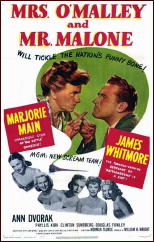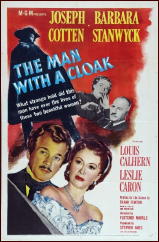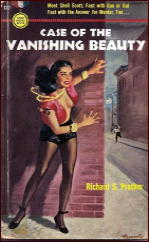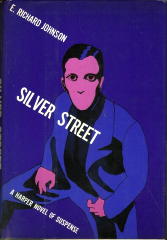Tue 18 Feb 2014
Mike Nevins on EQMM, RICHARD S. PRATHER and More.
Posted by Steve under Authors , Columns , Magazines , Reviews[9] Comments
by Francis M. Nevins
Thanks to my office (where I keep my computer) being closed down for the holidays, followed by the frightful weather, followed by some health issues, I expected that my February column, if any, would be culled from those old book notes I wrote for my eyes only back in the Sixties and Seventies.
Surprise! Thanks to Joseph Goodrich, editor of that priceless selection from the letters between Fred Dannay and Manny Lee published in 2012 as BLOOD RELATIONS, I am now in possession of all the material from their correspondence that for space or other reasons Joe didn’t include in his book. There are gems in that material, which over the next several columns I’ll dole out here.
In a letter dated March 31, 1950 and not included or excerpted in BLOOD RELATIONS, Fred tells Manny that for years he’s been trying to interest various movie studios in subsidizing Ellery Queen’s Mystery Magazine’s annual story contests, arguing that an investment of as little as $10,000 would lead to an “increase in submitted stories,†“interest by bigger names,†and — always a high priority with Fred considering his background in the advertising biz — publicity.

Approached by Fred, MGM executives told him that “they have invested millions of dollars in literary contests, but never got a single desirable piece of property out of it….now they wouldn’t contribute $10, let alone $10,000.â€
Not long after that exchange, MGM bought the movie rights to a second-prize winner in the latest year’s EQMM contest, “Once Upon a Train†by Craig Rice and Stuart Palmer, in which the authors’ respective series detectives John J. Malone and Hildegarde Withers teamed up to solve a railroad mystery.
Since the story wasn’t published until the October 1950 issue, MGM must have bought it from manuscript. (Those who have learned from Queen to read with extreme care may think Fred might have misdated his letter and actually wrote it in 1951, but this possibility is ruled out by his later statement to Manny that the story “has not yet appeared in EQMM….â€).
Fred queried the suits at MGM and was told that they had only bought the story because they “‘had a spot for the use of two characters like Withers and Malone,’ a spinsterish schoolteacher and a dipso lawyer.†Later Fred learned that MGM’s original plan was to use the story as a vehicle for Marjorie Main and Percy Kilbride, who had scored a big hit as Ma and Pa Kettle in THE EGG AND I (Universal, 1947).
By the time the movie had been released, one actor and one character had been axed from the initial conception: Marjorie Main still starred but as Harriet “Hattie†O’Malley, not Miss Withers, and John J. Malone was still the leading male character but was played by James Whitmore. For anyone who wants to waste an hour watching this turkey, its title is MRS. O’MALLEY AND MR. MALONE (MGM, 1950).

In the same letter to Manny, Fred reports that MGM has also spent $5,000 buying movie rights to John Dickson Carr’s short story “The Gentleman from Paris†(EQMM, April 1950). This move baffled Fred as much as MGM’s purchase of rights to the Rice-Palmer story.
As everyone knows who has read Carr’s excellent tale, which is set in 1840s New York, the climactic revelation is that the main character is none other than Edgar Allan Poe. “[S]urely MGM does not intend to keep the identity of the detective a secret….â€
Fred couldn’t figure out what the studio had in mind but any interested reader can find out by watching THE MAN WITH A CLOAK (MGM, 1951), a not-half-bad historical crime thriller starring a mustached Joseph Cotten as the Poe character (who calls himself Dupin) and Barbara Stanwyck and Leslie Caron as the female leads.

With a bit of space left over, I return to fields I plowed almost fifty years ago with comments on first novels by authors writing under their own names. Let’s begin with a writer whom I knew slightly and once, near the end of his life, lunched with at his lovely retirement home in Sedona, Arizona, armed with an assortment of first editions of his books, some of which he said were in better condition than his own, all of which he signed for me.
Richard S. Prather (1921-2007) was one of the first superstars of the paperback original, turning out a torrent of books for Fawcett Gold Medal in the Fifties and early Sixties which millions of readers gobbled down like Thanksgiving turkeys. I didn’t read them in order but, when I got to his first Shell Scott caper, CASE OF THE VANISHING BEAUTY (Fawcett Gold Medal pb #127, 1950) I had to concede that most of its plot and characters were lifted bodily from Chandler’s THE BIG SLEEP and FAREWELL, MY LOVELY with a few perfunctory variations.
One of a millionaire’s two spoiled daughters engages Scott to locate her missing sister and the trail leads LA’s coolest PI to the usual sinister nightclub, phony religious cult, dope smuggling, flying bullets, you name it. Prather had the gifts of pace and raw storytelling talent from the get-go but what distinguishes this otherwise routine programmer is Scott’s narration — bemused, self-mocking, gorgeously funny, and so wildly individual that he’s never been successfully imitated. He was, as we cruciverbalists say, a oner.

Bridge grandmaster Don Von Elsner (1909-1997) threw his hat, or perhaps I should say his lei, into the mystery ring with THOSE WHO PREY TOGETHER SLAY TOGETHER (Signet pb #S1943, 1961). Troubleshooter Colonel David Danning is hired by the board of directors of a packaging empire to protect its subsidiaries from a status-hungry gangster turned corporate raider.
The trail leads from a Chicago boardroom to Honolulu’s most lavish hotels and encompasses some superb stock-market shenanigans and a couple of murders which Danning must solve while on the run from both mobsters and cops.
At the climax all the characters unmotivatedly congregate for a Danning solution which is almost pure guesswork, but the pace is swift and the tooth-and-claw power struggles among tycoons seem to ring true.

SILVER STREET (Harper & Row, 1968) introduced the mystery world to E. Richard Johnson (1938-1997), a convict serving a life term at Minnesota’s Stillwater State Prison. It’s a short and unadorned tale of the mean streets in a nameless city where a modern Jack the Ripper is slicing up the local pimps for no discernible reason.
Streetwise homicide dick Tony Lonto’s hunt for the killer inevitably leads him to the discovery that his own girlfriend is a nympho and a whore. (Wouldn’t a streetwise cop have discovered this sooner?)
Superficially the book is tough as nails but it’s drenched with cloying romanticism beneath the surface. Nevertheless it won an Edgar for best first novel, an award which was duly presented to Johnson in the prison visitors’ room.
He wrote four more Lonto books and several other novels before being released in 1991 but by then his writing career was washed up and he died a few years later. So does crime pay or doesn’t it?
February 19th, 2014 at 1:34 am
Oh, no, a few weeks ago Half.com listed a copy of People vs. Withers for less than $5. Now the cheapest copy is $24.12! And that’s for the International Polygonics reissue. Pfui.
February 19th, 2014 at 4:59 am
For a bad-weather job, this was really nice! Enjoyed your comments on Prather and Johnson–you’re right: Johnson had a tough edge to his writing, but that’s all he had, I think his problem as trying to write Mysteries instead of Crime Novels. And MAN WITH A CLOAK is indeed an interesting film!
February 19th, 2014 at 10:11 am
I just looked at my big stack of Richard Prather paperbacks and it has been a very long time since I read a Shell Scott novel. I have THE CASE OF THE VANISHING BEAUTY and will read it soon.
February 19th, 2014 at 12:49 pm
Been years since I read The Vanishing Beauty and all I recall is how different sounding it was from the ribald OTT of the later titles like Strip for Murder or Kill the Clown. As I worked through the series, I came to realize that the first half dozen or so Scotts are rather pedestrian; a new writer finding his voice. Interesting tidbit: Prather’s first Scott novel was on the stands the same month as the final issue of Dan Turner, Hollywood Detective. How’s that for a classic passing of the Hollywood PI torch?
February 19th, 2014 at 10:41 pm
Couldn’t disagree with you on any of these. Though Whitmore as Malone almost redeems that turkey.
Even though you know it is Poe the final scene still has a nice frisson as the rain washes the poem.
Prather is what used to be called an onlie begetter. I know he had Bellem and others to model on, but Scott is unique as is Prather’s mind. It always amazed me how book after book he pulled off being howlingly funny, screwball, tough as nails, sexy, and a touch surrealistic with such ease.
Agree on Von Elsner too. I read several by him — usually revolving around bridge whether spy or mystery novel. They were pleasant reads, which today seems quite an accomplishment.
February 20th, 2014 at 2:36 am
Hi,
I do hope you’re doing well and recovered from those darn health issues that pop up now and then. It’s interesting that you mentioned Richard S. Prather as he was on my mind the last few days, February 14, being the anniversary of his death 7 years ago. He had such a sense of humor and gave Shell Scott much (or more) of that same humor. But what Richard took so seriously in writing was plot. In our telephone and written communications, he always emphasized PLOT as the secret to good writing. And in the exclusive interview (his last) I did with him, he spoke a lot about it.
February 20th, 2014 at 2:42 am
Mike,
Re: Fred Dannay and Manny Lee…what I found interesting about their writing relationship was the length of a draft done by one…? was it Fred? Like 120 pages or more?
Seems it was a book well on its way by that time. However they managed to collaborate, it obviously worked out just fine.
February 21st, 2014 at 2:14 pm
I tried to read one of Van Elsner’s bridge mysteries and I hated it. That card game baffles me. I keep hoping one day someone can make bridge exciting on paper (or at least make it’s unfathomable rules easily understood by the uninitiated) but I have yet to find the mystery novelist who did it. I may tackle MURDER AT BRIDGE by Ann Austin later this year as I liked her ONE DROP OF BLOOD so much.
Tony –
Cheapest copy I find of People vs. Withers & Malone is $7. There are umpteen other bookselling sites out there. I didn’t even know half.com was still in business!
February 21st, 2014 at 2:55 pm
John
I’ve been away from the computer for most of this week, so I haven’t spoken up till now, but I’m of the same opinion as you when it comes to Von Elsner.
Here’s my review of the second book in the David Danning series, Just Not Making Mayhem Like They Used To:
https://mysteryfile.com/blog/?p=689
Not my cup of tea at all.